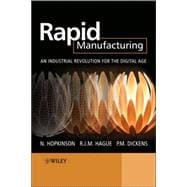
What is included with this book?
Phill Dickens is Professor of Manufacturing Technology and Director of the Innovative Manufacturing and Construction Research Centre at Loughborough University, UK. He is also Associate Dean of Research for the Engineering Faculty. Phill started work in the area of Rapid Prototyping in 1990, working on processes such as 3D Welding and using copper coated SL models as electrodes for EDM. The research work has changed emphasis since then from Rapid Prototyping to Rapid Tooling and is now concentrating on Rapid Manufacturing.
Richard Hague is a Senior Lecturer and Head of the Rapid Manufacturing Research Group at Loughborough University, UK. He has been involved with Rapid Prototyping and Rapid Manufacturing (RM) research since 1993, and is now Principal Investigator on several large EPSRC, DTI and EU funded research projects. He was also instrumental in setting up and managing the successful Rapid Manufacturing Consortium that now operates from Loughborough. Richard has many academic publications in the area of Rapid Manufacturing and is referee to several international academic journals and conferences. He also holds a patent that was gained as part of his PhD studies which is licensed to the predominant manufacturer of Rapid Prototyping equipment (3D Systems Inc.).
|
|||
|
|||
|
|||
|
|||
|
|||
|
|||
|
|||
|
|||
|
|||
|
|||
|
|||
|
|||
|
|||
|
|||
|
|||
|
|||
|
|||
|
|||
|
|||
|
|||
|
|||
|
|||
|
|||
|
|||
|
|||
|
|||
|
|||
|
|||
|
|||
|
|||
|
|||
|
|||
|
|||
|
|||
|
|||
|
|||
|
|||
|
|||
|
|||
|
|||
|
|||
|
|||
|
|||
|
|||
|
|||
|
|||
|
|||
|
|||
|
|||
|
|||
|
|||
|
|||
|
|||
|
|||
|
|||
|
|||
|
|||
|
|||
|
|||
|
|||
|
|||
|
|||
|
|||
|
|||
|
|||
|
|||
|
|||
|
|||
|
|||
|
|||
|
|||
|
|||
|
|||
|
|||
|
|||
|
|||
|
|||
|
|||
|
|||
|
|||
|
|||
|
|||
|
|||
|
|||
|
|||
|
|||
|
|||
|
|||
|
|||
|
|||
|
|||
|
|||
|
|||
|
|||
|
|||
|
|||
|
|||
|
|||
|
|||
|
|||
|
|||
|
|||
|
|||
|
|||
|
|||
|
|||
| 13.5 NASCAR. | |||
|
|||
|
|||
|
|||
|
|||
|
|||
|
|||
|
|||
|
|||
|
|||
|
|||
|
|||
|
|||
|
|||
|
|||
|
|||
|
|||
|
|||
|
|||
|
|||
|
|||
|
|||
|
|||
|
|||
|
|||
|
|||
|
|||
|
|||
|
|||
|
|||
|
|||
|
|||
|
|||
|
|||
|
|||
|
|||
|
|||
|
|||
|
|||
|
|||
|
|||
|
|||
|
|||
|
|||
|
The New copy of this book will include any supplemental materials advertised. Please check the title of the book to determine if it should include any access cards, study guides, lab manuals, CDs, etc.
The Used, Rental and eBook copies of this book are not guaranteed to include any supplemental materials. Typically, only the book itself is included. This is true even if the title states it includes any access cards, study guides, lab manuals, CDs, etc.